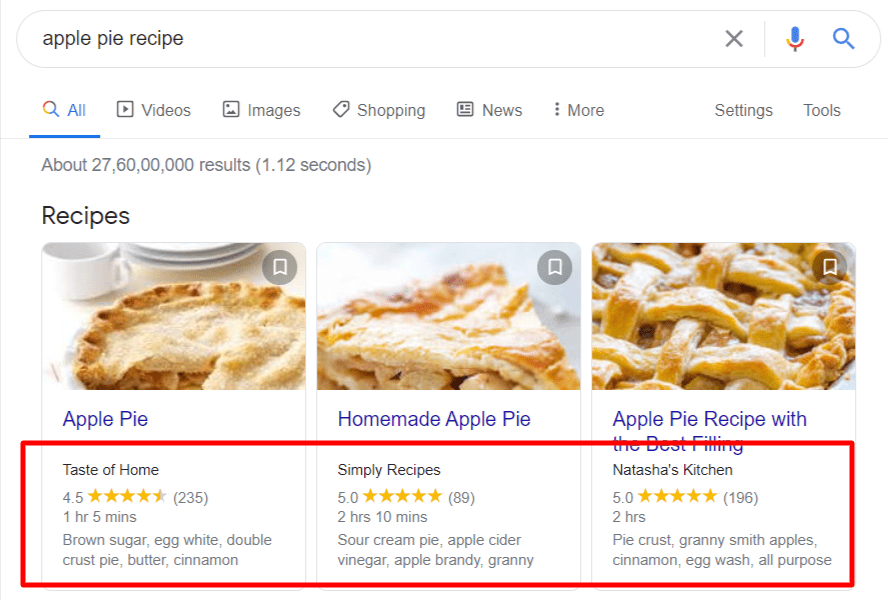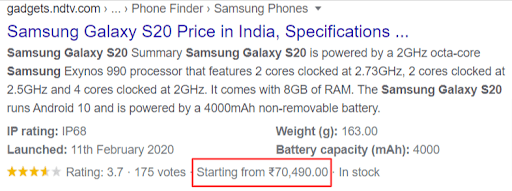Did you know that more people search Google for shopping ideas than they do on Amazon? This is according to a study on Search Engine Land.
Granted, your e-commerce site is more visible when you tweak your SEO strategies to be more visible on Google. Google keeps updating its features to offer its users a better experience. Rich snippets are some of the features that Google has added.
What are Rich Snippets?

Rich snippets are boxes of information that appear at the top of Google’s SERP. They allow you to see products or content relevant to your search, see consumer reviews, and get answers to your questions all from the same page section. As a webmaster, your customers can see everything about your products and even compare prices even before they open your website.
Google shows rich snippets for various categories including events, recipes, places, products, authors, and reviews among others. As a webmaster, rich snippets offer you a way to show your products, reviews, and prices.
Why are Rich Snippets Important?
Google Rich snippets will not help you rank higher. No matter how many snippets you use, they will not have any effect on your ranking. However, you can use the snippets to boost your SERP rank indirectly.
Rich snippets enable search engines to better understand your business. When Google gathers enough information about you, they are able to crawl your site deeper for enhanced ranking. As such, you need to make your site more Google-friendly. So when the bots come, they can find information.
By having a rich snippet appear on the first page of Google, you increase your chances of getting clicks from your potential customers, more traffic, and increased revenue. These are more important than where you rank for specific search terms.
According to a study by eConsultancy, people are more attracted to snippets with reviews. At least 63 percent of people filter through reviews before they buy products. The same research shows that reviews raise sales by up to 18 percent. Even bad reviews can improve conversions by more than 67 percent.
With rich snippets, you can control how your e-commerce brand information shows up on SERP. This way, you can avoid misinformation that can hurt your brand.
Product Rich Snippets

These snippets show basic information on products. You might see a photo, product name, product price, and star rating. Other snippets do not have a photo but instead show a basic description of the product. To show the information, the webmaster uses Schema Markup code.
There are different ways that you can display the information that appears in a snippet. Choose the information that benefits your prospective buyers the most. For instance, if you offer a product with a different dimension from all the others, you need to input that in the schema markup. You can see different structures of Schema on Schema.org.
If the information on Schema.org looks confusing, you can check Google’s Structured Data Helper which has a user-friendly interface. The Helper will guide you through creating the product snippet. You only need to pick the product type, URL, and follow prompts. Once you generate the HTML, you need to add it to your website. If adding the challenges you, use a plugin.
Rating & Reviews Rich Snippets

At least 90 percent of shoppers have to read a review before they buy a product. As such, you need to offer reviews to attract shoppers. You can boost the confidence of your shoppers by adding reviews. The reviews snippet can appear in the corner of the page. It includes trusted reviews from other websites or reviews from specific websites. The snippet can also have a link where the shoppers can access more reviews.
The reviews snippet doesn’t need to have complex details. You only need to include a star rating next to the product to show interest. Most consumers consider star ratings when shopping. The schema markup is the easiest to add compared to the others.
Price Rich Snippets

Comparison shopping is common with shoppers. About 46 percent of online shoppers take online price comparisons before they shop. The price schema markup allows you to place the price information front and center of the search engine results page.
When shoppers search for a specific product, they will see its price against other items. For someone who is looking for a product based on price, they will disqualify a product or products from the first SERP.
There are different factors you can list on the price snippet including price changes and discounts. The process of adding a price schema is the same as adding any other schema markup. Open Google Structured Data Markup and click Offer >> Price. You will get a code that you can place in your website for the price snippet to show up in search results. You can include tags such as Sale or Discount so shoppers can notice your products with ease.
Breadcrumbs Rich Snippets

A breadcrumb list shows where a page sits on a site’s hierarchy. Adding a breadcrumb snippet makes it easier for users to explore a site with ease. A user can follow a breadcrumb trail that leads them from the page in the lower levels all the way to the top. Your Breadcrumb needs to have at least two items.
To add a BreadcrumbList, you need to create Global Snippets in your WordPress dashboard. From there, you can add a BreadcrumbList as your main schema. Once you create the schema, you need to add items that will make up the list. You can add as many items in the list as you need depending on how deep you want it to be.
You need to fill details such as name, item, and position.
Availability Rich Snippets

![]()
Your customers will feel disappointed if they discover a good product only to realize that it is not available. To save them the disappointment, add an availability snippet to show your customers when a product is out of stock and inform them that they have to join the waiting list. Your customers do not want to keep coming back to your website to check the availability of a product so you need to add them to a waiting list.
Adding the availability snippet can help reduce bounce rates from your website. Soft bounces are especially common when customers are not sure whether a product is in stock. These bounces occur when someone clicks through your website, browses through but they do not buy. Soft bounces can be due to missing product information or due to products being out of stock.
If price discourages a buyer, they might leave immediately. However, someone who engages with the website and does not buy may have been discouraged by product unavailability. You can find the schema markup at Schema.org.
Video Rich Snippets

If you create products that need videos, adding a video helps you market your products with ease. For instance, if you sell hearing aids, you can create videos that show people how to use them and this will help your sales.
You can also use the same videos as explainer videos in your e-commerce site. If you are already using rich snippets, you should add videos to make your products stand out. Videos are ideal for all products that need explainer content. Your videos need to be short and entertaining to keep the consumers watching.
There are several ways to create explainer videos and so many services that can help you do it. The video snippets ensure that you rank high and your customers connect with your products.
Conclusion
You can use rich snippets to offer your customers enough information on products and attract them to your site. You can also use rich ads to help you rank higher on search engines. The rich snippet will help you sell your items more but the rich ads will ensure you get a higher rank. Paid ads, known as rich ads can help you reach more customers when used together with rich snippets.
You can choose to add the schema code or pay for sponsored snippets. Your snippets will show a sponsored tag at the top but they will appear on the first page of Google. The process of adding rich ads is the same for rich snippets. With the ads, you get to choose which images, which products, and what information appears in the snippet. The rich ads can help increase store visits by up to 108 percent.
About the author
Rithesh Raghavan is the Director at Acodez, a Digital Agency in India, and the co-founder of Acowebs, an online store for eCommerce plugins. Having a rich experience of 15+ years in Digital Marketing, Rithesh loves to write up his thoughts on the latest trends and developments in the world of IT and software development.
Don’t forget to share this article


